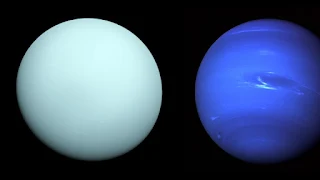Using a special imaging technique, scientists have discovered three never-before-seen celestial bodies orbiting Neptune and Uranus, all of which are moons.
According to scientists, two of them orbit Neptune, the farthest planet in the solar system from our star, and one orbits Uranus, the seventh planet farthest from the sun.
Uranus already has 27 confirmed moons, and the new moon, the first moon to be discovered around the planet in more than 20 years, is likely to be the smallest, measuring 8 km across. It will likely take 680 days to orbit the planet.
Meanwhile, among Neptune's new moons, the "faintest" moon was observed by ground-based telescopes.
There are 14 confirmed moons of Neptune, including a moon called Triton, which is about the same size as our moon and contains active volcanoes. With the new discovery, the total number of known Neptune moons reaches 16.
The International Astronomical Union's Minor Planet Center recently announced the new discoveries. Scott Sheppard of the Carnegie Institution in Washington said: “The three newly discovered moons are the faintest ever seen around these two icy giant planets using ground-based telescopes. It required special image processing to reveal such faint objects.”
The new Uranus satellite has been temporarily named S/2023 U1. It is believed to be the smallest moon orbiting the planet.
Ultimately, S/2023 U1 will be given a name from a Shakespeare play, in keeping with naming conventions for Uranus' moons.
Shepard discovered S/2023 U1 in November last year when using the Magellan telescopes at the Las Campanas Observatory of the Carnegie University of Science in Chile.
In December 2023, he made follow-up observations to confirm the discovery. He used the same telescope to discover one of Neptune's new moons.
A team including David Thulin of the University of Hawaii, Chad Trujillo of Northern Arizona University, and Patrick Sophia Lekawa of Kindai University helped Shepard confirm Neptune's second moon.
Both of these objects were spotted for the first time in 2021, but they have not been confirmed as new moons of the planet.
The brightest new moon of Neptune is called S/2002 N5 and is about 23 km across. It takes about nine years to orbit the ice giant. While the second moon, S/2021 N1, is about 14 km wide, and it orbits for about 27 years.
Ultimately, both moons will be named after one of the goddesses, mermaids - sea nymphs, numbering 50 in Greek mythology, as is customary.
The three newly discovered moons have distant and “eccentric” orbits, which means that their orbits around their planets are not completely circular.
“Once the orbit of S/2002 N5 around Neptune was determined using the 2021, 2022 and 2023 observations, it was traced back to an object that was observed near Neptune in 2003 but was lost before it was confirmed to be orbiting the planet,” Sheppard said.
Scientists used many time-intensive exposure imaging techniques to make lunar discoveries. They now hope that finding new moons will help them understand more about the history of our solar system.






Nice discovery!
ReplyDelete